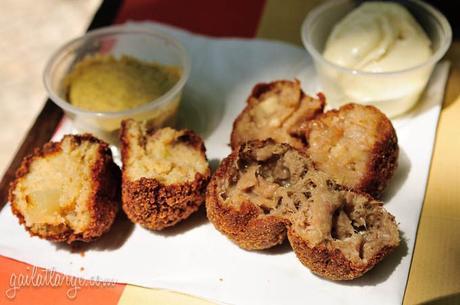
Croquetes do not a meal make, but they are just the right size as a lanche (afternoon snack) and for late-night petiscos (Portuguese tapas) with your beverage of choice. In Portugal they’re hardly ever labelled, which makes the ordering either problematic or adventurous, depending on how you like to eat.
The world loves croquettes (from the French croquer, “to crunch”); you’ll find many variations of it under local names on every continent — assuming the folks in Antarctica make them, too. Some of my personal favourites are kroketten in Dutch bars, korokke in Japanese restaurants (I love the tonkatsu sauce that comes with it), and croquetas in Spain. The commonalities are that they have a shell (usually bread crumbs) with a filling and are typically fried. Otherwise it varies widely by country and region — in size, shape, filling, and condiment (if there is any).
I happened to buy these “SuperCroquetes” at Croqueteria in Time Out Market/Mercado da Ribeira in Lisbon (€1.50 each), but you can easily make them at home or find them anywhere around Portugal in various forms. The three flavours you see here are:
- LEFT – bacalhau, with bacalhau and chouriço;
- TOP RIGHT – queijo, goat’s cheese and caramelized onions;
- BOTTOM RIGHT – tradicionais de carne, with a mix of braised beef and pork and chouriço. They’ve posted their recipe here.
The first two are original to Croqueteria, if I’m not mistaken. I ordered the sauces out of curiosity (mostarda/mustard and alho/garlic mayo) because condiments are rare in Portugal. I don’t like ketchup, but I love mustard and freshly-made mayonnaise (not the stuff in jars with preservatives, it’s really not the same). Both were delicious, not to mention a generous portion and an absolute steal at 25 cents each. I even had enough to use them at lunch.
By far the tradicionais de carne is the one croquete you’ll encounter most often around Portugal, but in a much smaller size. The traditional ones are with meat: vitela (veal), porco (pork), and vaca (beef, not to be confused with bife, which describes a cut rather than the meat itself) or a mix of these. If you’re hoping to see vegetarian versions or croquetes mixed with vegetables like mushrooms, look for student campuses or tourist zones.
Croquetes are the kind of food I like to eat out versus make because they are really too much trouble to cook at home, with all the oil required for deep-frying and our lack of freezer space. Growing up in Winnipeg, my family had a deep freezer and a large pantry; all winter we’d eat the food we bought and processed ourselves in bulk. In this southwest corner of Europe the growing season is long and Portugal in particular has relatively high electricity rates; freezing food for months doesn’t make sense here. There’s a reason why fried foods are common in hot countries: they don’t spoil as quickly without refrigeration.
Another reason croquetes make a better eat-out versus eat-in food is the best part of petisco-style eating — a multiplicity of flavours in small amounts. I wish I could eat like this every day, but it’s totally inefficient to replicate this situation at home. It’s possible to make each variety in large batches, but then there’s the storage and reheating. Compare that to the very small price of typical croquetes (under a euro each) that you would eat once in a while, not daily, and it’s no contest.
I don’t know about you, but I’ll pay a few euros to get out of the kitchen and leave the deep-frying (and the smell and mess) to the croqueterias. Even with the element of surprise that is an unlabelled croquete.

August 14, 2016
Album: Lisbon 2016

